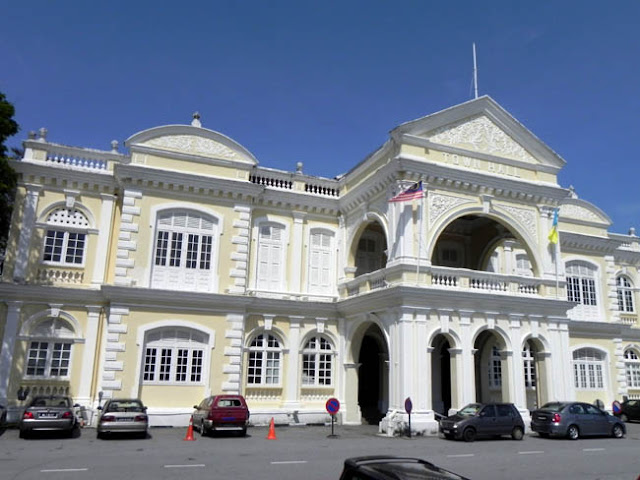Chulia Street is located in the heart of George Town, right in the middle of the UNESCO Heritage Site. Staying at Chulia Heritage Hotel was really a good choice, location wise.
Staring from our hotel, we toured around the UNESCO World Heritage Site at 9 am, heading westwards until we reached Penang Road. After taking our breakfast at one of the coffee shops there, we turned into Lebuh Leith (Leith Street) to visit Cheong Fatt Tze Mansion. We turned back to Muntri Road, then reached Lebuh Light (Light Street) through Lorong Love (Love Lane). From Light Street, we travelled into Lebuh Pantai (Beach Street), had our lunch at a kopitiam and, visited Peranakan Mansion before we make our stop at Khoo Kongsi along the street. We stepped our foot back into our hotel at around 4 pm, covering a distance of 4.5 km, by foot.
Along our way, we saw different types of old shops, which their age can be determined by their architecture styles. The Southern Chinese style (upper left) was the oldest shops that we could identify, which were built between 1840-1890. Early Strait style shops (upper right) can be found at Love Lane. They were built between 1890-1910. We came across some shops built in Late Strait style (lower left) at Muntri Road, while Early Modern style shops are everywhere across George Town area. We learned the knowledge about architecture styles of the shops from this penang shophouses blog.
We reached this blue building at the end of Leith Road around 10 am. It was a mansion, which now serves as a boutique hotel. This edifice has won several international awards, which include the highly recognized "Most Excellent Heritage Conservation Award", which was given by UNESCO. It is a popular movie filming site as well. More information about Cheong Fatt Tze Mansion can be found at its official website. We didn't go into the mansion, as the first tour started only at 11 am. We need to pay RM12 per person for the tour. Many had mentioned that the tour is somehow overrated. Our advice, why not take a look on their comments, and then, make your own decision.
We came across this Hainan Temple, which was built in 1895 at Muntri Road. This temple serves the goddess of Mazu. What you can't miss about this temple is the fine sculptures on it's walls and the pillars (as some of them can be seen at the pillars of the arch).
The Goldsmith's Guild (upper left) at Muntri Road and Carpenter's Guild (upper right) at Love Lane are two of the oldest trade associations in Penang. We entered the Carpenter's Guild and saw a very fine sculpture was hanged in the middle of the guild (lower right). Love Lane is an old street, which the name might has the connection to the illicit liaison of mistress, which was once quite popular at the street.
We met this historical Church of Assumption at the junction between Love Lane and Light Road, which was built more than 160 years ago in 1860. This church can accommodate more than 1000 congregation in a single mass.
The pictures designed with stained glass in the church are the lighting windows, decorative pictures, and the story tellers.
St. John Church is located just beside Penang Church of Assumption. This should be a very popular place wedding photo taking. How did we know about that? Take a look on the notice below...
Commercial photography and pre-wedding photography is NOT ALLOWED.
We took a short rest in front of Penang Town Hall, as the pedestrian path over there was well shaded. There are three main heritage sites beside Light Street- Penang Town Hall, Penang and Fort Cornwallis. Penang Town Hall was built in 1880. It was once been called the "Ang Mo Gong Kuang", or The Meeting Place of the Foreigners by the locals.
The Building of Penang Municipal Council was built in 1903, and still functional until today.
We reached the entrance of Fort Cornwallis, with the sun blazing 90 degree above us. This is the fort which was built by Francis Light in 1786. Lucky, and we were saved from the stinging heat by the trees planted inside the fort.
The building of Fort Cornwallis marked the starting of British colonization in Penang. From what we can see, many of the cannons are facing the sea, make the fort a powerful British stand against the Malay army from the peninsular mainland. The design of the fort showed that Francis Light had the intention to take over Penang by force, from the very beginning of his plan. A small chapel was built in the fort (lower left), while some parts of the wall were reconstructed (lower right).
Along Light Road, we turned right when we met this sixty feet tower. The tower was built in commemorating the Jubilee of Queen Victoria in 1902 (the construction started in 1897, but the Queen died before the completion of the tower). The building was sponsored by Cheah Cheng Eok, one of the richest men in Penang at that time.
We took a lunch break at an air conditioned Kopitiam, next to Standard Chartered. We continued our journey along Beach Street after the lunch. Follow us now!
All our sharing on Penang are available at:
[Penang Batu Feringghi Beach] [Penang Butterfly Farm and War Museum]
[Penang World Heritage Site Part 1] [Penang World Heritage Site Part 2]
[Penang World Heritage Site Part 1] [Penang World Heritage Site Part 2]














No comments:
Post a Comment